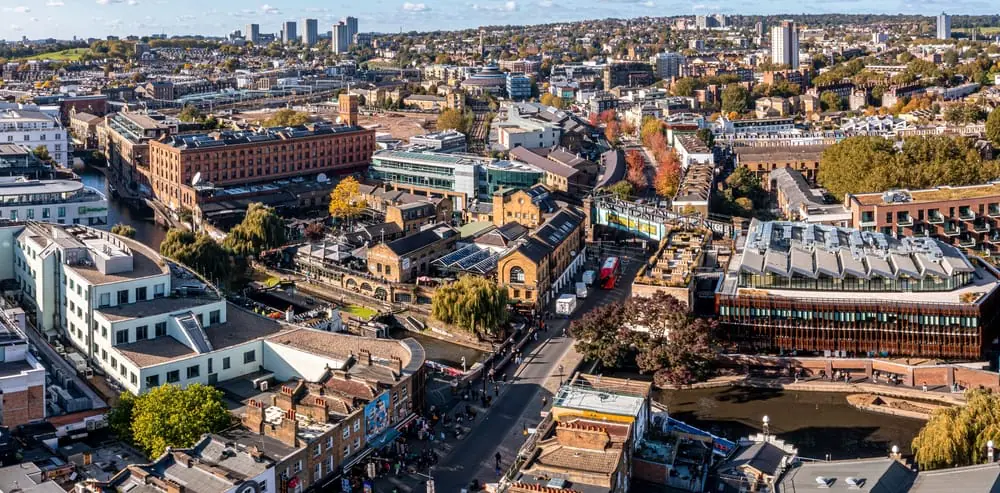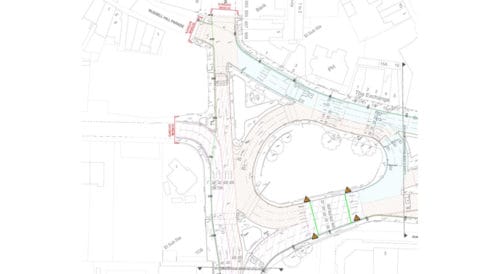Cycle Safety Scheme: Transforming Camden’s Roads

The Holborn Cycle Safety Scheme, introduced as part of Camden’s Healthy Streets, Healthy Travel, Healthy Lives: Camden Transport Strategy 2019-2041, has a primary goal of eliminating Killed or Seriously Injured (KSI) casualties on Camden’s Road by 2041.
The scheme was designed to enhance safety measures around the Holborn Gyratory. It included immediate and short-term measures. Immediate measures comprised segregated cycle lanes, bus lane improvements, and enhanced traffic lights for cyclists.
The Challenge
The London Borough of Camden (Camden) appointed Metis to develop their road cycle safety scheme designs into detailed, buildable plans for their immediate and short-term measures. Our highway engineering team had to ensure the project could be completed on time and consider safety for workers while avoiding significant disruption on a key junction on Camden’s network. In addition, Metis worked to reduce the embodied carbon by looking at innovative design and the reuse of materials.
After the successful implementation of the immediate and short-term measures, The London Borough of Camden requested we develop a comprehensive design package for the expanded road space of the Holborn Gyratory. This encompassed Southampton Row, Theobalds Road, Drake Street, Procter Street, Red Lion Square, Fisher Street, Catton Street, High Holborn (including the junction with Kingsway), and Kingsway up to the junction with Remnant Street (See Location Map below).
The Solution
The Holborn Cycle Safety Scheme was delivered in three stages. Our Highway Team proactively partnered with the appointed traffic modelling consultant, Transport for London (TfL), and the contractors appointed by Camden. This collaboration was crucial for the successful execution of the project.
Here’s how we approached each stage of this pivotal scheme.
Holborn Safety Scheme – Immediate Measures (2021):
For the immediate measures, our infrastructure team further developed the appointed traffic modelling consultant’s design into a detailed plan. We conducted a thorough risk assessment during the design stage to identify potential hazards, establishing a solid foundation to ensure the project’s feasibility for construction by October 2021.
The detailed design package comprised of kerbs, footways, pavements, drainage, traffic infrastructure ducting, road markings, and traffic sign drawings, as well as 3D modelling, covering essential components for implementation.
In preparing the construction package, we prioritised the use of standard materials for swift implementation. This ensured the inclusion of all pertinent documents within the construction pack, facilitating the initiation of construction in line with the demanding schedule.
Holborn Safety Scheme – Short Term Measures (2021/22):
In this phase, our team conducted a thorough buildability review of various proposed options, assessing their feasibility as replacements for the temporary measures previously implemented.
Additionally, our designer’s risk assessment recorded identified hazards during the design stage. To tackle challenges including obstacles such as mature trees at the new bus stop site and existing structures beneath the carriageway in the proposed cycle lane segregation island, our design introduced solutions aimed at minimising disruptions without impacting pedestrian and cyclist movements.
Holborn Cycle Safety Scheme (Ongoing since 2022):
In the final stage, our detailed design incorporated a new layout within the existing carriageway without encroaching on footway space. Additionally, our design aligned with TfL requirements for extended bus stops, incorporating sustainable solutions such as increasing greening by 35% mostly in the form of Sustainable Drainage Solutions (SuDS) features and introducing tree planting.
Together, our focus was on enhancing the geometric layout and functionality of the gyratory. For instance, our design included additional changes to accommodating and preserving bus capacity and prioritising cycling and walking. This involved targeted site investigations that minimised both time and cost, ultimately delivering an optimal design solution for the area.
The Outcome
- Our detailed design assisted in improving cycle infrastructure and enhancing safety for cyclists and pedestrians. As well as contributing to the development of Camden’s public realm.
- The project’s success relied on our agile approach to deal with unforeseen challenges, our expertise and experience in detailed design, and our approach to collaboration among stakeholders. Our team contributed to overcoming constraints, accommodating design changes, and meeting multiple stakeholders’ needs, ensuring successful project delivery.
- The first phase of works on Kingsway including the Junction with High Holborn was completed in August 2023 and the construction of the rest of the scheme was completed in September 2024.
Interested in learning more about our work?
Explore some of our other Metis case studies to discover our recent projects. Or, if you’re seeking an experienced and passionate civil and environmental engineering team to partner with on your next project, please get in touch with us today.


